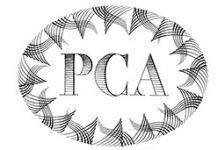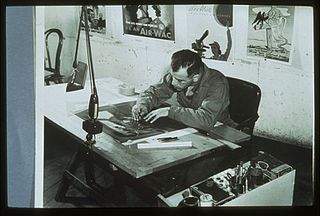
Rockwell Kent was an American painter, printmaker, illustrator, writer, sailor, adventurer and voyager.
Donald Culross Peattie was an American botanist, naturalist and author. He was described by Joseph Wood Krutch as "perhaps the most widely read of all contemporary American nature writers" during his heyday. His brother, Roderick Peattie (1891–1955), was a geographer and a noted author in his own right. Some have said that Peattie's views on race may be considered regressive, but that expressions of these views are "mercifully brief and hardly malicious".

Wood engraving is a printmaking technique, in which an artist works an image into a block of wood. Functionally a variety of woodcut, it uses relief printing, where the artist applies ink to the face of the block and prints using relatively low pressure. By contrast, ordinary engraving, like etching, uses a metal plate for the matrix, and is printed by the intaglio method, where the ink fills the valleys, the removed areas. As a result, the blocks for wood engravings deteriorate less quickly than the copper plates of engravings, and have a distinctive white-on-black character.

John Anthony Baldessari was an American conceptual artist known for his work featuring found photography and appropriated images. He lived and worked in Santa Monica and Venice, California.

Lynd Kendall Ward was an American artist and novelist, known for his series of wordless novels using wood engraving, and his illustrations for juvenile and adult books. His wordless novels have influenced the development of the graphic novel. Although strongly associated with his wood engravings, he also worked in watercolor, oil, brush and ink, lithography and mezzotint. Ward was a son of Methodist minister, political organizer and radical social activist Harry F. Ward, the first chairman of the American Civil Liberties Union on its founding in 1920.
Frederick Monhoff was an American architect, artist, and illustrator. His architectural style ranged from art deco to mid-century modern, while his etchings of the 1920s-30s documented scenes of Native American and Mexican life in the American Southwest.
Jacob Israel Zeitlin was an American bookseller, publisher, collector, poet and intellectual in Los Angeles in the mid-twentieth century.

The Print Council of America is an organization that seeks to "foster the creation, dissemination, and appreciation of fine prints, old and new." It is primarily a group of museum curators, but also includes university professors, conservators of works on paper, and independent scholars involved in the study of prints.
Harry "Ward" Ritchie was an American printer, book designer, book collector and writer of around 100 books. He was part of the "Golden Age" of fine printing that took place during the 1920s and 1930s in Southern California. Ritchie was also part of the Artists of the Arroyo Seco community.
Richard Wagener is an American wood engraver known for his prints and fine press books. His work has been collected by over one hundred and thirty public institutions. His first livre d'artiste, Zebra Noise with a Flatted Seventh, was included in Artists' Books in the Modern Era, 1870–2000 at the Legion of Honor, Fine Arts Museums of San Francisco. Victoria Dailey has called Wagener the first California artist since Paul Landacre to achieve prominence in the art of wood engraving.

Laurence Evelyn Hyde was an English-born Canadian film maker, painter, and graphic artist, known for his work with the National Film Board of Canada, stamp designs for the Canadian Postal Service, and the wordless novel Southern Cross (1951).
Kate Steinitz, informally known as “the Mama of Dada,” played a significant role in the history of art on a number of levels: in the creation of her own art works, as a preserver and collector of the art of her times, as a promoter of art and artists, and, for the last thirty years of her life, as a librarian of the Elmer Belt Library of Vinciana, first when the library was based in the collector's medical offices in downtown Los Angeles, and later as honorary curator when the collection was given to UCLA in 1961.

Anthony Velonis was an American painter and designer born in New York City who helped introduce the public to silkscreen printing in the early 20th century. He married Elizabeth Amidon, with whom he had four children.

Ynez Johnston was an American painter, sculptor, printmaker and educator. Known for her work in painting, printmaking, and mixed media, Johnston was particularly inspired by Byzantine art, as well as Tibetan, Indian, Mexican, and Nepalese art from her extensive travels. Johnston was based in Los Angeles.
Leon Gilmour (1907–1996) was an American artist, designer, teacher, illustrator and laborer. He is best known for his social realist, wood engravings featuring laborers or California landscape and nature. His work is often associated with the Regionalist artists.
William "Skinny" Elijah Smith (1913–1997) was an African American artist who was recognized for exploring Black experiences in his art. Friend and poet Langston Hughes once described Smith's work as the "humor and pathos of Negro life captured in line and color."

The Elmer Belt Library of Vinciana is a special collection at the University of California, Los Angeles which focuses on Leonardo da Vinci – life, art, thought, and enduring cultural influence. It is the most extensive research collection concerning Leonardo in the United States. It was donated to UCLA in several installments between 1961 and 1966 by Dr. Elmer Belt (1893-1980), an internationally recognized urologist; a pioneer in gender-affirming surgery; a strong supporter in the founding of the UCLA School of Medicine; an important public health advocate; and a lifelong bibliophile and book collector.
Asa Cheffetz (1896–1965) was an American artist and printmaker. Although he worked in various media, he is best known as a wood engraver.
Nina de Creeft Ward is an American artist who works with bronze, soft sculptures, etchings, woodcuts, and monoprints. She had multiple art exhibitions in the Philippines and the United States. Ward was the co-winner of the Individual Artists Award for Works in Clay in 2006 from the Santa Barbara Arts Fund. Most of Ward's work has to do with animals, including a 1998 exhibition of art that resembled endangered and extinct species. She has taught students such as at the University of Northern Iowa. Her clay animal models are made with raku ware.
This is a timeline of 20th-century printmaking in America.









